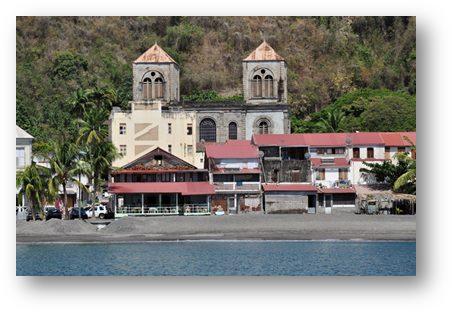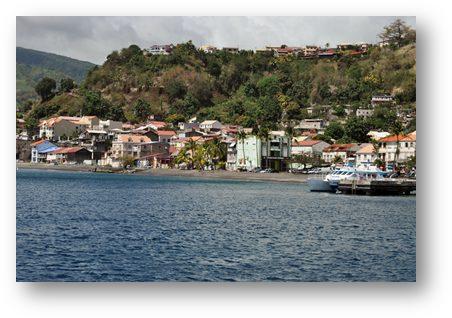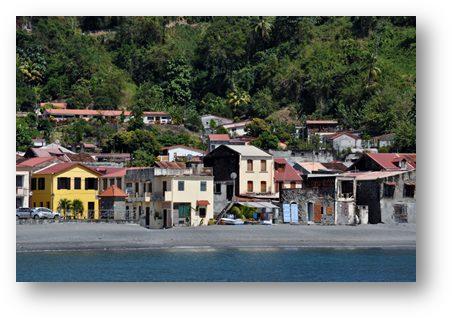St Pierre, Martinique

Position: 14:44.44N 61:10.68W Date: Saturday 13th April 2013 We sailed the 7 or 8 miles north along the coast to the town of St Pierre, so that we could clear out of Martinique and head across to the next island north of us, Dominica. We dropped anchor at about 11:30 am but the town’s tourist office, where we had to go to complete the checking out procedure, closed at 12:00am which was just too early for us to get ashore and get there. So we were in St. Pierre for the weekend, whether we liked it or not. Well we did like it; it is a very interesting town with an eventful recent history. The town lies at the foot of Mt Pelée, an active volcano. Its summit is way above cloud level and its lower slopes are a wild profusion of different shades of green supporting a combination of farmed crops such as sugar cane, pasture and woodland.
The dock where you leave your dinghy when you go ashore has quite a bit of swell that can cause damage to an unattended dinghy. The solution is to use a small anchor to hold the dinghy away from the concrete structure of the dock. We went ashore one evening and on our return, after dark, I found that the anchor had stuck fast to something on the seabed. The only solution was to cut the line, leaving the anchor and chain on the bottom. Fortunately, having been a boy scout, I had a small knife with me. The next morning I was able to dive over the area and find my anchor. A creature that looked remarkably like a sea snake was trying to get itself into the same hole that my anchor was stuck in, so extricating it was a rather nervous procedure. I kept re-assuring myself that there are no sea snakes in the Caribbean and that it must have been a spotted eel, but nevertheless I treated it with extreme caution. The history of the town is quite well known but for those unfamiliar with it the basic story is outlined below. By the end of the 19th century St Pierre was a prosperous and culturally rich city that was known as the Paris of the Caribbean. It had a population of around 30,000 people. The richest sugar plantations in Martinique lay around it and their trade was conducted through the town’s port. In early April 1902 there was an eruption that covered the town in ash, followed by another one in early May. A few of the inhabitants left but the majority took the decision to stay. The Governor urged the population not to flee and he was backed up by the planters and business leaders who would have suffered large losses if the town had been evacuated. There were also important elections coming up and black voters were for the first time becoming a serious political force, so the local paper was also telling people to stay. On 8th May 1902 the volcano erupted catastrophically. The side facing St Pierre exploded releasing a pyroclastic flow that engulfed the town below, completely destroying it and its inhabitants. Near to 30,000 people were burned to death. There were only two reported survivors, Leon Leandre the town cobbler, and most famously Cyparis who was in a stone cell in the town gaol where he was being held for murder. He was badly burned but when he was eventually found, treated and released he joined a circus where he would display his scars and tell his story. There are still many ruins that you can see in the town, sometimes forming part of a later building. The town museum has a fascinating display of exhibits from the time, together with old photographs and copies of various newspaper cuttings. |



